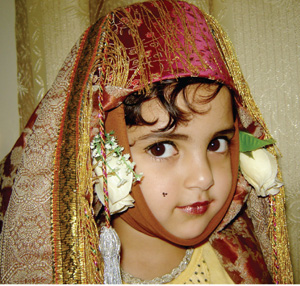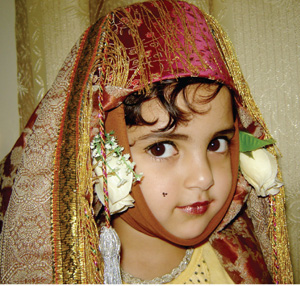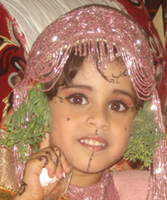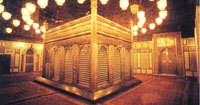
Women’s festive head coverings A folklore fashion show (Part 1) [Archives:2007/1037/Last Page]
March 29 2007
 |
 |
fatimafnfr@yahoo.com
On various women's occasions, Yemeni women in their traditional dresses make a daily show. Despite the new fashionable dresses displayed in most markets, Yemeni women still prefer to wear traditional dress and their head coverings on most occasions. Some women wear traditional dress as a standard on formal occasions. In this article, we'll examine some Yemeni head coverings and when they are worn.
Certain traditional Yemeni dresses are only for married women and it's forbidden and shameful for a single woman to wear them socially. Thus, most traditional dress is especially for married women. Additionally, some married women's dresses are worn only on specific occasions and it's socially unacceptable for a woman to wear it outside of these occasions.
Al-Ospah is a special headdress for a new mother or bride. New mothers wear Al-Ospah during the final days of the 40-day birth celebration, while newlywed brides wear it on their honeymoon. The headdress consists of three parts: one part covering the head while the other two are used as a necklace and bracelet.
It's unacceptable for women who aren't new mothers or brides to wear Al-Ospah, as it's a traditional belief that only a bride or a new mother have the right to be distinguished on their occasions.
Al-Asjah mostly is a bridal headdress worn during the honeymoon period made of special Sana'ani cloth and with a special design. Every bride must have such a headdress among her new marriage clothes.
Wearing Al-Asjah requires the assistance of a professional woman because it's difficult for a bride to put on herself. Some women who can do Al-Asjah make a career of it and earn good money.
Al-Masar, Al-Tali'a and Al-Nazili are considered the uniform headdress of every married woman, especially in Sana'a, and are meant to distinguish the married from the single women at women's gatherings or parties. Married women may wear it on any occasion.
It's easier to wear than Al-Asjah and Al-Ospah because it doesn't require the assistance of another woman to put it on. It has two main parts: a scarf covering the hair and a piece of plastic covered with a decorative scarf worn around the upper part of the woman's head.
On some occasions, Yemeni women prefer to wear Al-Masar, Al-Tali'a and Al-Nazili as a display of formal respect for the occasion, such as religious parties called Nasheed or Mawlid.
Yemeni women have always used flowers and jewelry in their dress – especially for head coverings – as decoration to make them more attractive and beautiful.
——
[archive-e:1037-v:14-y:2007-d:2007-03-29-p:lastpage]


